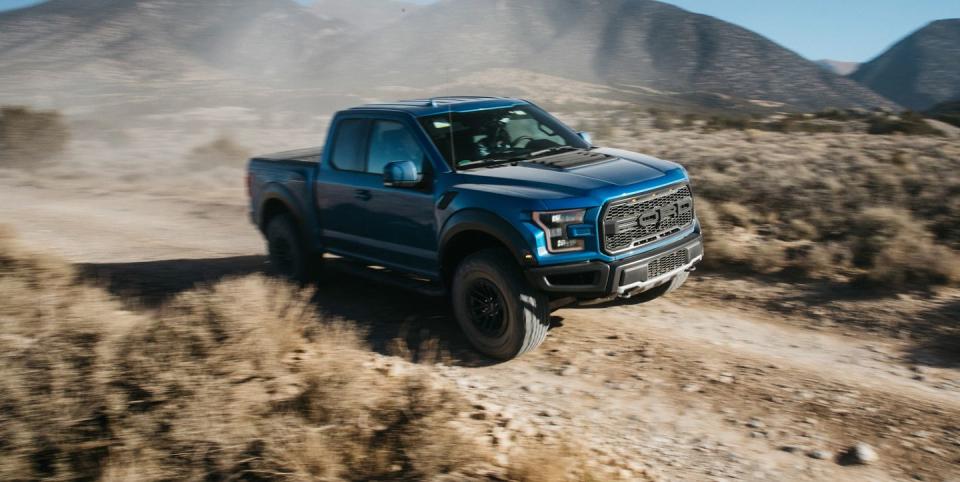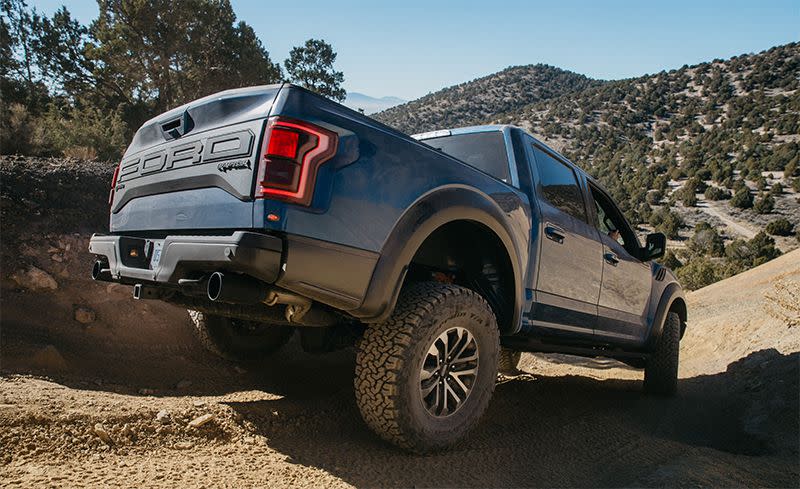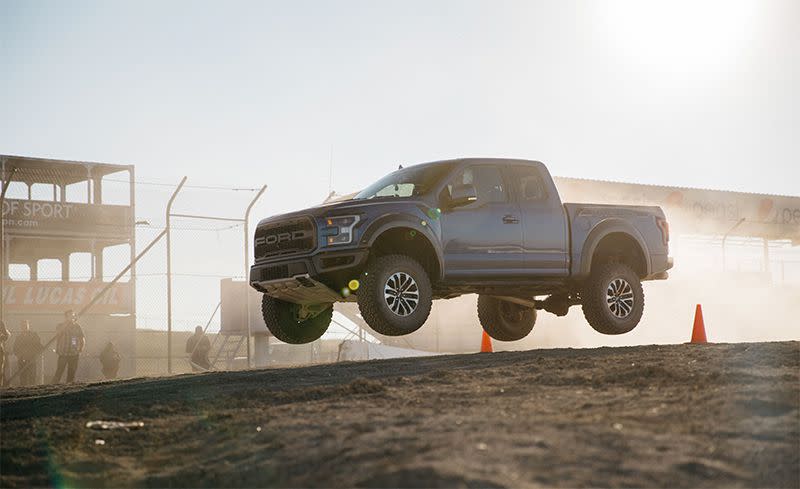The 2019 Ford F-150 Raptor Desert Racer Becomes a Better Rock Crawler

Annihilating sandy washes with four-wheel powerslides, launching sideways off eroded gullies, and sailing effortlessly over whoops is what Ford's F-150 Raptor was made to do. So it was surprising that Ford included only low-speed rough roads and even lower-speed rock crawling in our drive of the revised-for-2019 pickup. Nonetheless, the dusty trails around Salt Lake City did allow us to effectively sample the 2019 Raptor's other major revision-Trail Control-which is essentially low-speed cruise control that manages the truck's speed up- or downhill between 1 and 20 mph.
But it's in the high-end dampers-Fox twin-tube bypass units-where this truck's spirit lies. They were the breakthrough technology that gave the original Raptor its character and have provided this second-generation truck with staggering ability since its introduction in the 2017 model year. For 2019, all Raptors come with dynamic dampers, a technology Fox calls Live Valve. The Live Valve actuator controls the oil-flow rate through the base compression valve, which provides variable damping control during the compression stroke. Rebound damping remains passively metered. In this application, Ford utilizes the same continuously controlled damping (CCD) controller used on Lincoln products but with software written specifically for the Raptor. The programming accounts for the Raptor's position sensors on the front suspension and considers a number of other inputs as it continuously adjusts damping at all four corners, including setting them to full stiffness when the truck goes airborne.
On-road benefits exist, too. Roll-control functionality-which increases the outside dampers' resistance to compression during cornering-is present in Normal and Sport modes but is disabled in the off-road modes (Baja, Rock Crawl, Mud/Sand), where it would create understeer. The rest of the Raptor's suspension hardware-its upper and lower front control arms and live rear axle-remain the same, retaining the 13.0 inches of front and 13.9 inches of rear travel it has been blessed with since its debut.
Certainly the 2019 Raptor remains wildly capable, at least at modest speeds, rounding off square-edged rocks and breezing over substantial hits that would send standard half-ton trucks home on a flatbed. And it's no less enjoyable, either, gliding over two-tracks strewn with loose rocks and scarred with drainage ruts. But in the environment in which we experienced the truck, none of this makes it obviously better than the passive-damper version it replaces. The Raptor is amply capable on slow-going rock trails, but they certainly aren't its forte. Evaluating a Raptor on surfaces better suited to a Jeep Wrangler did nothing to demonstrate the truck's hard-running ability.
Trail Control, however, is a substantial improvement over the now dead hill-descent control, adding the ability to maintain a preset speed while climbing. The feature frees up a driver's mental bandwidth, which would otherwise be used to operate the pedals in the low-speed, high-angle environment of rock crawling-a learned skill that requires extreme care. Drivers without rock-crawling experience will save themselves a few rocker scrapes with this new feature. Activating Trail Control in Rock Crawl mode permits setting the speed in 0.5-mph increments, which provides precise control to place the 34-inch BFGoodrich All-Terrain T/A KO2 tires. A 4.10:1 rear axle is standard and a Torsen limited-slip front differential remains optional as part of the 802A equipment package.
The only other significant change is the addition of available $2395 Recaro seats (included in the Interior Color Accent package), which are a welcome item in a truck that begs to be thrown around in the desert. They're more supportive than the standard seats, adding bolstering to the seatback and cushion. But the change that matters most is the use of blue microsuede inserts to those areas, which hold passengers in place better than leather-only seats or obtrusive bolsters.
The Raptor's twin-turbo 3.5-liter V-6 is unchanged for 2019, producing 450 horsepower and 510 lb-ft of torque, so we expected no difference in performance from previous Raptors we've tested. In Michigan, our 2019 test truck hit 60 mph in 5.1 seconds, about the same as the quickest current-generation Raptors we've tested. The quarter-mile vanished in 13.9 seconds at 99 mph, also on par with other Raptors. Despite the addition of roll control via the dynamic dampers, we measured the same 0.70 g on the skidpad that we've recorded in previous Raptor tests.
Ford will ask for an additional $2180 for the 2019 Raptor, bringing the base price for a SuperCrew model to $57,335 (the smaller SuperCab starts at $54,350). The additional two grand is not a small increase for what was already an expensive truck. And, though it's hard to say that the new Raptor is two grand better, we do know there isn't another vehicle out there that can do what it will do.
('You Might Also Like',)

 Yahoo Autos
Yahoo Autos 

